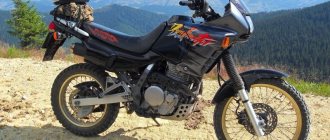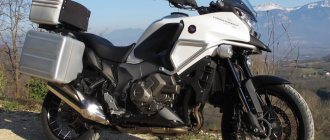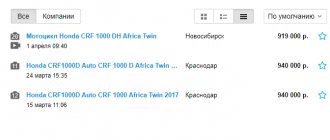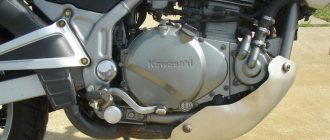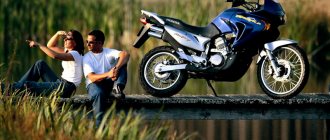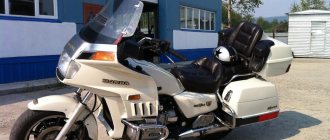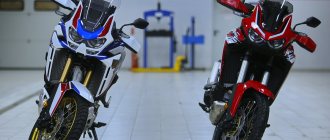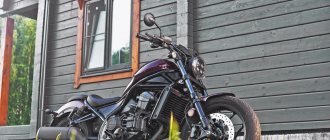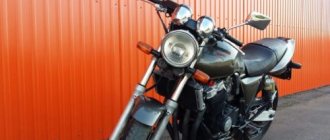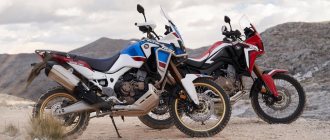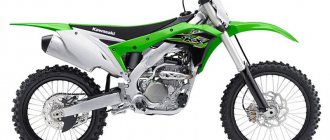- motorcycle model, Honda brand,
The Honda XRV 750 Africa Twin touring enduro model appeared in the Honda motorcycle line in 1990, replacing the Honda XRV650 Africa Twin. The updated model has received a number of improvements - from a larger engine to a new shape of the front fairing. In this article we will not touch on all the technical differences between the XRV750 and XRV650, since the latter model is quite rare and is practically not found on the market.
The Honda XRV750 Africa Twin model is usually divided into two generations:
1990-1992 — generation RD04 (frame number starts with RD04~).
1993-2000 — generation RD07 (frame number starts with RD07~ or JH2RD07~). It differs from the RD04 in overall dimensions, ergonomic parameters (saddle height, etc.), reduced fuel tank (from 24 to 23 l), updated plastic design, wheels and carburetors (vacuum CV instead of flat throttle ones). There were also slight differences in models by year of production - they are described in more detail in the “Technical Specifications” subsection.
The Honda XRV 750 Africa Twin is based on a 2-cylinder V-twin liquid-cooled engine with a volume of 742 cc. see, producing up to 62 hp. power and up to 63 Nm of torque. Maximum engine performance is at 5500-7500 rpm. It should also be noted that the maximum power and torque figures differed depending on the countries of sale. Above are the maximum specifications for European versions. The Japanese ones produced 57-58 hp. and 60 Nm.
Other features of the Honda Africa Twin 750 include a steel frame, long-travel off-road adjustable (rear shock absorber) suspension, large 21′ and 17′ spoked wheels, a 24 liter fuel tank (23 liters - RD07) and 234-236 kg curb weight.
2000 was the last year of production of the model, but official sales continued until 2004. The Honda XRV750 Africa Twin has become a truly iconic motorcycle that is extremely popular to this day. Simplicity, reliability and unique off-road characteristics made the motorcycle an excellent option for traveling on any roads and destinations.
In 1999, Honda announced a continuation of the legendary “Africa” called the Honda XRV850 Africa Twin (80 hp), but the prototype never went into production. Instead, Honda released the flagship enduro-tourer Honda XL1000V Varadero, which, although it became popular, did not repeat the success of “Africa”.
In 2014, Honda decides to resurrect the Africa Twin brand by introducing to the market a new flagship in the heavy off-road enduro class - the Honda CRF1000 Africa Twin. In fact, this motorcycle was supposed to be a response to the European giants of the motorcycle industry with their flagships - the BMW R1200GS, Ducati Multistrada and Triumph Tiger Explorer. After all, despite the presence of the Varadero, and then the Honda VFR1200X Crosstourer, there was not a single truly off-road enduro-tourer in the Honda motorcycle line, like the Honda XRV750 Africa Twin was at one time.
The main competitors of the Honda XRV750 Africa Twin in the class:
Yamaha XTZ750 Super Tenere
Bike features
The motorcycle has the following advantages:
- surprisingly high cross-country ability;
- really powerful engine;
- ease of landing.
However, it would take a very long time to list the advantages of this model. It is not only beautiful in appearance and characteristics, but also very reliable. The motorcycle will hardly need any repairs. It is hardly possible to imagine something more suitable for long trips.
2021 Honda Africa Twin
As for the 2021 Africa Twin, it is very far from the first version in terms of equipment and specifications. Against the backdrop of carburetors, flexible turn signals and the twitchy speedometer needle of the RD04, the new motorcycle seems like a spaceship. The second model to represent the 2021 Africa Twin in our test is called the Africa Twin Adventure Sports, and it can be equipped with a dual-clutch automatic transmission (DCT). Compared to the standard 2021 Africa Twin, the Adventure Sports has longer travel suspension, larger tank capacity, a larger instrument panel and an additional ride mode - Gravel. The DCT version has two clutches with an electronic drive - this is a complex automatic system that makes traction control simple and understandable: turn off the gas - go, turn it harder - go faster. But for those who like to click something, this version has buttons for manual transmission control on the left remote control. The characteristics of the 2021 Africa Twin, of course, also eclipse the old Africa of 1991: 93 horses, however, the weight has also increased and is 242 kg.
Engine
The bike is equipped with a wonderful V-shaped engine. This four-stroke and two-cylinder unit has a displacement of 742 cm³. The engine is cooled by liquid; there are three valves per cylinder. The fuel supply system is carburetor.
Peak engine performance: at 6500 rpm the torque is 62 Nm, and at 7500 rpm the power is 60 hp. The peak speed of the XRV 750 is 170 km/h, and the car will accelerate to 100 km/h in 4.6 seconds. These characteristics alone do not provide an understanding of why the model is so good.
Model history
1990 - start of production and sales of the Honda XRV750 Africa Twin. First generation. Model: Honda Africa Twin 750 (Japan, Europe). Frame number: RD04~ (Europe), RD04-1000001 to RD04-1000389 (Japan). Factory designation: XRV750L.
1991 - without significant changes. Model: Honda Africa Twin 750 (Japan, Europe). Frame number: RD04~ (Europe), RD04-1030001 to RD04-1030350 (Japan). Factory designation: XRV750M.
1992 - without significant changes. Model: Honda Africa Twin 750 (Japan, Europe). Frame number: RD04~ (Europe), RD04-1060001~ (Japan). Factory designation: XRV750N.
1993 - the model is restyled. Second generation. The motorcycle receives a new frame (4 kg lighter), a more advanced air filter mount (the filter itself was located slightly higher), a slightly shortened pendulum, a reduced (by 2 cm) seat height, modified brake calipers (for easier replacement of pads), fuel 23 liter tank and redesigned plastic and new carburetors (CV instead of flat throttle). The rear suspension increases travel by 4 mm. The maximum power of European versions is reduced to 60 hp. Model: Honda Africa Twin 750 (Japan, Europe). Frame number: RD07~, JH2RD07~ (Europe), RD07-1000001 to RD07-1000174 (Japan). Factory designation: XRV750P.
1994 - no significant changes. Model: Honda Africa Twin 750 (Japan, Europe). Frame number: RD07~, JH2RD07~ (Europe), RD07-1100001 to RD07-1100150 (Japan). Factory designation: XRV750R.
1995 - The model receives all-transistor ignition, which slightly improves fuel efficiency and increases maximum power (for Japanese versions). The bike also gets a new seat, clutch and muffler. Versions starting from this year have gold-colored wheel rims. Model: Honda Africa Twin 750 (Japan, Europe). Frame number: RD07~, JH2RD07~ (Europe), RD07-1200001 to RD07-1200100 (Japan). Factory designation: XRV750S.
1996 - the model receives new carburetors. Model: Honda Africa Twin 750 (Japan, Europe). Frame number: JH2RD07A~, JH2RD07B~, JH2RD07C~, JH2RD07D~ (Europe), RD07-1300001 to RD07-1300117 (Japan). Factory designation: XRV750T.
1997 - no significant changes. Model: Honda Africa Twin 750 (Japan, Europe). Frame number: JH2RD07A~, JH2RD07B~, JH2RD07C~, JH2RD07D~ (Europe), RD07-1400001 to RD07-1400243 (Japan). Factory designation: XRV750V.
1998 - no significant changes. Model: Honda Africa Twin 750 (Japan, Europe). Frame number: JH2RD07A~, JH2RD07B~, JH2RD07C~, JH2RD07D~ (Europe), RD07-1500001~ (Japan). Factory designation: XRV750W.
1999 - no significant changes. Model: Honda Africa Twin 750 (Japan, Europe). Frame number: JH2RD07A~, JH2RD07B~, JH2RD07C~, JH2RD07D~ (Europe), RD07-1600001~ (Japan). Factory designation: XRV750X.
2000 is the last year of production. Model: Honda Africa Twin 750 (Japan, Europe). Frame number: JH2RD07A~, JH2RD07B~, JH2RD07C~, JH2RD07D~ (Europe), RD07-1610001~ (Japan). Factory designation: XRV750Y.
Dimensions and weight
The curb weight of Honda's XRV 750 is 234 kg, while its dry weight is 207 kg. This weight cannot be called too much for a touring motorcycle of the level of this model. The fuel tank capacity here is 23 liters, which is very good for such a bike. Actual gasoline consumption is about 6-7 liters for every 100 km of road. The length of the motorcycle is significant - 2320 mm. The width of the XRV 750 is 905 mm, and the height is 1430 mm. The wheelbase is impressive – as much as 1555 mm. The height of the model at the saddle is 870 mm.
Review of the Honda XRV 750 Africa Twin motorcycle
Africa immediately, from the first seconds, envelops you with an aura of comfort and security. The motorcycle seems to tell you: show me the way, and I’ll do the rest myself. There is no need to fight with him, it is enough to establish a connection with him at the soul level - unity is guaranteed. And then go out onto the highway and drive several hundred kilometers, just for fun. But the comfort of Africa is not the comfort of a luxury tourer; not a single tourer is suitable for Russian roads. And Africa is adapted. And at the same time, it is absolutely reliable, in this very few people can compare with it. There are very few such completed, successful motorcycles; it’s a shame that Africa, like many real, “correct” motorcycles, has been no longer produced since 2003.
Africa will solve absolutely all the tasks that you set for it! It's hard to imagine a more versatile motorcycle than the Honda Africa Twin 750! The motorcycle is tall, comfortable, and has excellent light. Africa can take you with excellent comfort on almost any surface - from asphalt to sandy tracks!
1. Preface.
Actually, I didn't want the tour. enduru (and didn’t even know they existed). I always wanted a road bike or a sports tourer...and I almost bought one, but a few months before the purchase I found myself on a bike trip in Karelia and asked the question “what will the bike (and its pilot) be like when they’ve been here?” .
Then I started reading about off-road reports and I saw the light. Like many, I chose the first motorcycle based on appearance and very rough ideas about how the tabular performance characteristics relate to real life. After I saw Africa - the selection process could be considered over - this motorcycle literally smelled of distant distances. A good company of like-minded people from africatwin.ru clearly explained everything to me, dispelling the last doubts.
2. Quick inspection.
The motorcycle is really big - tall and heavy (about 200 kg of dry weight + liquid + up to 23 liters in the tank). So big that after Africa, following the landing of the butt on the saddle of other models, the question often arose “why is he so small?” By the way, after the purchase I had a lot of concerns about whether I could handle it, but luckily everything worked out fine.
Maybe this is due to lack of experience, but later the dimensions had a negative impact on the driveability in traffic jams. Another point is to lift the motorcycle (in case of falls on the ground, for example) - it’s quite a tedious task, although over time you get used to it. A high center of gravity increases the chances of dropping the motorcycle if it begins to roll and at the same time makes it somewhat more difficult to climb.
Another point is to lift the motorcycle (in case of falls on the ground, for example) - it’s quite a tedious task, although over time you get used to it. A high center of gravity increases the chances of dropping the motorcycle if it begins to roll and at the same time makes it somewhat more difficult to climb.
3. Sores.
Strange as it may seem, no one was able to really criticize the motorcycle - legends were (are being added, and, I hope, will be added) about reliability - an engine with a mileage of more than 100 thousand km without capital is a normal phenomenon.
Of the known jambs - the speedometer is always dying (due to the cable and gear) - after the new gear was licked 50 km away - I splurged on GPS. The second problem is the fuel pump (replaced with a Micuni vacuum pump). In more rare cases, the muzzle becomes loose and the relay-regulator dies.
Although, here, of course, you need to make allowances for the age of the motorcycle - there are none newer than 2003, and they are, as a rule, not used for trips to the store. If something, God forbid, breaks, you can spend a lot of money on treatment (this rule applies to most Japanese). So, for example, at the end of the season, I began to experience bad sounds from the clutch basket, which resulted in its replacement. In general, the experience of colleagues shows that if you take care of your motorcycle, it will serve faithfully for a long time.
3. Engine.
As you know, the engine migrated to Africa from the VT500 chopper (now deceased) - so you shouldn’t expect dynamic miracles from the motorcycle. However, in justification, I can say that I can’t even call the 750 cc V-Twin a “brake”. Let's just say the engine is calm. Comfortable (for me) speed is around 120 (+/- 10) km/h - up to this point the device accelerates quite vigorously, then vibrations begin to grow exponentially (once stopping after a rather long hold in the “140+” mode, I I found some difficulties in lighting a cigarette - my hands were shaking :)). It’s possible, of course, faster - if necessary, it will go (for example, go out to overtake in cruising mode - no problem), but why?
The downside is a characteristic feature of V-Twins - locomotive traction: the engine confidently pulls from the very bottom, which I appreciated the first time I went into the forest. Gluttony on the highway is 6-7 liters per 100 km.
4. On the move.
After picking up speed above 5 km/h, the weight of the motorcycle ceases to be felt and almost never reminds you of itself during control (except during active control on the ground). Outside the city, Africa shows all the signs of a long-range cruiser - it rides on asphalt like it’s on rails, inviting you to drive without unnecessary haste - here the heavy weight and dimensions are a plus.
The seating position is comfortable (if anything, my performance characteristics are approximately the following: 190/75), thanks to the wide handlebars, the hands practically do not become numb, the wide saddle allows the butt to retain its original shape for a long time, and if it suddenly begins to take the shape of this very saddle - in the absence of the second number You can take any comfortable position from near-chopper to “belly on the tank.” In general, I run 150 km at a time (between smoke breaks) easily and naturally (it’s not clear whether I used to smoke more often, or just out of habit).
Speaking of stopping, Africa’s brakes have a certain (non-critical) element of thoughtfulness. Although, if you brake to the floor, the situation improves noticeably.
Regarding the suspension, it allows you not to pay attention to the quality of the asphalt, behaves well on various graders and hard primers of varying degrees of lousiness, and in the city it easily eats up lying policemen. But as I gained speed outside the asphalt, I replaced the springs in the fork - hard impacts to the hands became a fairly common occurrence.
5. Improving.
If you have the finances, there is plenty to roam around here. First of all, I installed Givi arches; in general, there are arches from several manufacturers in Africa. Some, as it turned out, are located too low and do not protect the plastic very well from contact with the ground.
Next, a double adjustable glass (MRA) was installed - here again there is plenty to choose from, hard hand protection (Cycra), radiator and rear disc protection (noname from ebay), a home-made trunk, a cigarette lighter (from Volga), warm handles and automatic chain lubrication (Scottoiler). Replacement of the fuel pump remains on the list of unrealized plans.
Some maniacs completely replace the suspension with spare parts from WP (at that time I still didn’t understand why and what it was). It costs as much as an airplane wing, unfortunately. Of the major tuning catalogs, you should pay attention to https://www.africanqueens.de/ and https://touratech.com/
6. To summarize.
I'm happy with the motorcycle inside and out. It is very sad that this is a representative of a dying class of tours. endur - no longer shitty, but at the same time - not quite elephants yet. Only BMW and KTM have something similar.
I think that for those who have a great desire to travel far and for a long time, and also have no inclination to fly under 200, Africa will become a faithful friend and assistant both on the asphalt and beyond. Although, of course, the weight, dimensions and high center of gravity seem to hint to us that it is better to dive into swamps on something smaller. 
8. Current opinion.
I drove Africa (more specifically, it was an RD07 from 1998) for a season and a half, at some point realizing that I was definitely not mistaken with the class, but in terms of performance characteristics I want more (you can read about this in my review of the goose) - in particular, I began to drive faster, and attempts to go beyond comfortable cruising caused discomfort associated with vibrations.
Africa is an excellent tourist for a leisurely ride - it is comfortable on long journeys, a large spacious motorcycle with a minimum of electronics - they don’t make them like that anymore. Now, having tried the details of many of its classmates (F800GS, XTZ750, KTM 990, R1200GS) to varying degrees, I still think that it does an excellent job of solving its problems.
Let's just say - I once read a short and succinct review of the 990th “sportbike moved into the tour. enduru,” so if you rephrase this in relation to Africa, it turns out that it’s a tour. Enduru has been possessed by a chopper. To be more precise, its engine was taken as the basis. If you are used to a leisurely pace of driving, this will not create any problems for you. Plus, I believe, this is what had a positive effect on the service life of the motor.
As for the enduro component - I have to admit that Honda lost the arms race here - the Yamaha “pimp” seemed to me more dynamic, well-controlled and sharp in control (in places it reminded me of a goose-800). Of course, this does not mean that you shouldn’t drive off the asphalt in Africa - I started enduring on this motorcycle and it was in Africa that I did my first long-distance ride with long dirt chunks (about 1000 km on graders in Karelia) - you just need to understand if you If you plan to spend a really long time in the forest, there are better options for this.
In any case, during all this time I have never regretted buying this motorcycle - it was definitely a great start to the world of long-distance racing on two wheels.
Chassis and brakes
The frame is made of steel. Its contours impress with elegance and strength. There is something in the appearance of a motorcycle that declares its undeniable power and reliability. The colors are perfectly chosen. The wheels are spoked. The steering wheel is a convenient and reliable control tool.
The rear suspension has a travel of 214 mm; it is a pendulum version with a monoshock absorber. The front suspension is a telescopic fork with a size of 43 mm and a stroke of 220 mm. The rear brake is a 256 mm disc with a single-piston caliper. At the front there are two discs, each measuring 276 mm, and the caliper is two-piston.
Two Africas on the road
In order to keep up with the new Africa Twin, on the old one you need to shift in time and push harder, or put up with a slower pace, have fun with the powerful, smooth traction and clear throttle response of the carburetor engine. The old lady is damn fun to drive fast, she allows you to get the most out of your V-twin, and the brakes settle well before cornering. The old suspension behaves great on the road, not perfect, but doesn't do anything scary either. By the end of the mountainous section of the road I was sweating, the engine was hot, the tires looked tattered, and every corner had a black skid mark from the braking point to the apex.
Stopping nearby, his partner got off the new Africa and, smiling from ear to ear, took off his helmet. At the same time, he looked like after a relaxing massage session - relaxed and satisfied. That's what 30 years of development means - one pace, one road, same level of riders and two completely different bikes. I was almost screaming with delight at how smartly the old lady and I managed that sharp left turn, and my partner behind me was simply enjoying the views while listening to the music in his helmet, without feeling any excitement.
But when he pushed on the new Africa Twin, I could no longer keep up with him. We go through turns equally quickly, but the difference of 31 horses is clearly felt on every straight.
The difference in the characters of the two motorcycles on the road is absolutely amazing - on the old lady you always try your best to go fast, and she assents and plays along with you - yes, they push you, cool! And the new Africa happily rides behind the old woman, but at the first opportunity it will overtake and easily fly off into the distance. It's more comfortable, its brakes are better, and it always has enough traction to overtake almost anything. But for some reason she doesn’t encourage you to drive too fast.
What's the choice?
Well, if I had to choose which bike to hop on and go for an evening ride on the enduro track, I would choose the old Africa Twin 1991 RD04. I'm not an oldfag, but the old bike is so light, so willing to ride even outside its comfort zone, that it makes a great companion for fun rides. Well, we must take into account that I love tinkering with old hardware, so fixing a speedometer that failed during a test, starting it with a pusher due to a dead battery and gluing a turn signal hanging on the wires is just as much a thrill for me as driving this thing .
For long trips, my choice is definitely the new Africa Twin 2021. I’m ready to travel hundreds of kilometers with it, explore new routes and destinations, and see new places. Comfort, power and quality of the suspension allow you to focus on the ride and think less about how the motorcycle feels there. In every respect except perhaps weight, the new bike is king: ABS and traction control make it safer and allow you to go faster, the range is longer and the consumption is lower, the engine feels great at highway speeds, and nothing from it during the test didn't fall off.
It's always interesting to ride such an honorable old motorcycle and meticulously examine it in the bright light of the latest technology. In this regard, the 1991 Africa Twin RD04 is nothing to be ashamed of - it may be slower and less refined than new, but anyone who drives it will know that its reputation is well deserved. This is a motorcycle that inspires confidence on and off road, a motorcycle that encourages you to try your hand at yet another goat trail. And this is the bike that will take you home after all your adventures - well, maybe not without a little repair on the side of the road.
With such charisma, you really become attached to it with all your soul to such an extent that you deliberately ignore suspicious puddles under the engine.
